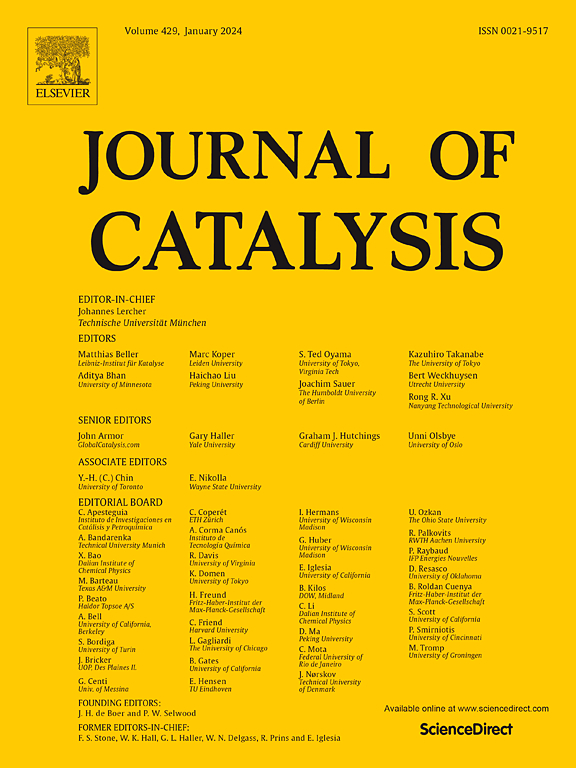用于酸催化甘油升级的镓基中空二氧化硅纳米球:通过深度核磁共振方法揭示的增强活性
IF 6.5
1区 化学
Q2 CHEMISTRY, PHYSICAL
引用次数: 0
摘要
采用软模板溶胶-凝胶法制备了掺杂ga的空心二氧化硅纳米球和纳米管。在合成过程中,只需调整搅拌速度即可获得低维形貌(0D或1D)。采用ssNMR、N2物理吸附、XRD、TEM或ICP-OES等技术对两种材料进行了表征。通过71Ga ssNMR验证了煅烧温度对镓配位环境和镓活性位点可及性的影响。以三甲基膦为探针分子,采用吸附氨的FT-IR和31P ssNMR相结合的方法研究了固体的酸性特征。与ga纳米管相比,后一种技术使得ga纳米球的Brønsted/Lewis酸位比更高,这可能是由于ga纳米管的球壳缺陷更大的结果。测试了两种纳米结构将甘油转化为索酮的能力。与相应的纳米管相比,ga纳米球显示出更高的催化性能,并且在相同的反应条件下,与文献中报道的其他固体催化剂相比,ga纳米球表现出出色的活性。此外,它们在多个循环中被证明是稳定和可重用的。在最佳条件下计算的e因子小于1,证明了该过程的可持续性。本文章由计算机程序翻译,如有差异,请以英文原文为准。


Gallium based hollow silica nanospheres for the acid-catalyzed upgrading of glycerol: Enhanced activity disclosed via an in-depth nuclear magnetic resonance approach
Ga-doped hollow silica nanosphere and nanotubes were synthetized using a soft template sol–gel method. The low dimensional morphologies (0D or 1D) were obtained by simply adjusting the stirring speed during the synthesis procedure. The two materials were fully characterized using different techniques such as ssNMR, N2 physisorption, XRD, TEM or ICP-OES. The influence of the calcination temperature on the coordination environment of gallium as well as the accessibility of the gallium active sites was proved via 71Ga ssNMR. The acid features of the solids were studied via a combined approach based on FT-IR of adsorbed ammonia and 31P ssNMR using trimethylphosphine as a probe molecule. The latter technique allows unveiling a higher Brønsted/Lewis acid sites ratio of Ga-nanospheres as compared to Ga-nanotubes, probably as a consequence of the more defective spherical shell. Both nanostructures were tested for the conversion of glycerol to solketal. Ga-nanospheres revealed improved catalytic performance in comparison with the corresponding nanotubes and displayed outstanding activity with respect to other solid catalysts reported in the literature and tested under the same reaction conditions. Moreover, they proved to be stable and reusable in multiple cycles. The E-factor calculated under the best condition was below 1 thus proving the sustainability of the process.
求助全文
通过发布文献求助,成功后即可免费获取论文全文。
去求助
来源期刊

Journal of Catalysis
工程技术-工程:化工
CiteScore
12.30
自引率
5.50%
发文量
447
审稿时长
31 days
期刊介绍:
The Journal of Catalysis publishes scholarly articles on both heterogeneous and homogeneous catalysis, covering a wide range of chemical transformations. These include various types of catalysis, such as those mediated by photons, plasmons, and electrons. The focus of the studies is to understand the relationship between catalytic function and the underlying chemical properties of surfaces and metal complexes.
The articles in the journal offer innovative concepts and explore the synthesis and kinetics of inorganic solids and homogeneous complexes. Furthermore, they discuss spectroscopic techniques for characterizing catalysts, investigate the interaction of probes and reacting species with catalysts, and employ theoretical methods.
The research presented in the journal should have direct relevance to the field of catalytic processes, addressing either fundamental aspects or applications of catalysis.
 求助内容:
求助内容: 应助结果提醒方式:
应助结果提醒方式:


